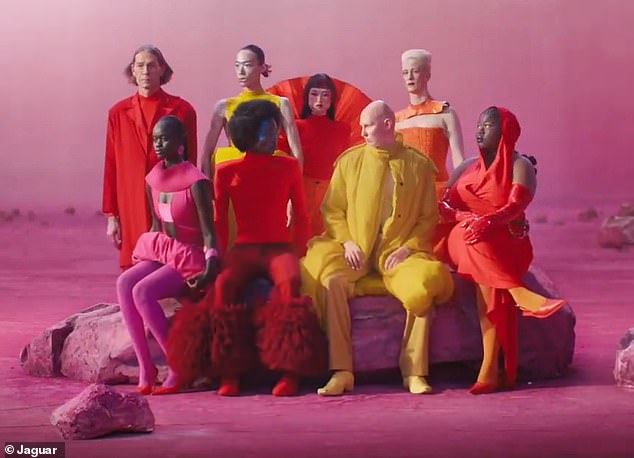Have you seen Jaguar’s latest effort to rebrand itself and appeal to a “younger, diverse audience”? If you haven’t, prepare yourself—it might be hard to recognize the luxury car brand responsible for decades of stylish, powerful vehicles. Instead of showcasing fast cars, sleek designs, or even so much as a steering wheel, Jaguar’s latest 30-second ad swaps it all out for surreal androgynous models, bizarre fashion, and cryptic messaging. And social media is not impressed.
Let’s break it down: just what is Jaguar trying to achieve with this controversial campaign? And why are so many current (and ex-) customers like me fed up?
What’s in Jaguar’s New Ad?
The ad opens with a yellow pod in a strange, alien-like landscape—probably designed to make you feel like you’ve landed on Mars. Out steps a group of models wearing avant-garde outfits: one has a skirt vaguely resembling a lampshade, another has puffy pom-poms around her ankles. Among the cast are models with shaved eyebrows, wild wigs, and—you guessed it—plenty of attitude.

Accompanying the surreal visuals are equally vague slogans like “Create exuberant.” “Delete ordinary.” “Copy nothing.” Oh, and by the time you blink and ask, “Isn’t this a car ad?” the Jaguar name appears for a few fleeting seconds. No cars. No engines. Certainly no roaring Jaguar spirit.
Why Jaguar’s Rebranding Feels Like a Trainwreck
For decades, Jaguar has built a legacy based on its luxurious and effortlessly British image. It’s a brand that exuded power, sophistication, and a slight touch of rebellion (need we remind you of Tom Hiddleston revving a Jaguar while quoting Shakespeare?). Owning a Jaguar wasn’t just about having a car; it was about making a statement: classy, masculine, and unapologetically bold.
But that identity seems to have been erased in a single weirdly abstract ad campaign. Customers like me, typically white, middle-class, British guys who’ve cherished Jaguar’s heritage, feel unwanted. And it’s not unintentional. Jaguar’s managing director, Rawdon Glover, made it clear that 85% of their future buyers are expected to be new customers—not the ones currently driving their cars.
I don’t know about you, but being told that I’m not welcome by the very car brand I’ve supported for years doesn’t exactly sit well.
Social Media Slams the Campaign
Well, social media hasn’t held back. Under the video on YouTube and other platforms, the comments came flooding in.
“How to destroy your brand in 30 seconds,” one user wrote.
“This isn’t a car ad; it’s a perfume ad gone wrong,” said another.
Others questioned why there wasn’t a single car in sight: “Umm, is this even about cars?”
Even billionaire Elon Musk chimed in on Twitter (now X), sarcastically asking Jaguar whether they still sell cars. Jaguar’s smug response? “Yes. We’d love to show you. Join us for a cuppa in Miami on December 2.” That’s a plug for their new all-electric sedan, which is rumored to cost £100,000.
But fans of Jaguar’s traditional sleek, high-performance cars aren’t biting—and they’re not afraid to let the brand know. Comments like “Go woke, go broke” are popping up everywhere, drawing comparisons to Bud Light’s “woke” marketing disaster earlier this year.
Lessons From Other Marketing Failures
Jaguar isn’t the first brand to alienate its core audience with an attempt to appeal to a younger, “trendier” demographic. Do you remember what happened to Budweiser’s Bud Light? When it paired up with transgender influencer Dylan Mulvaney in a bid to modernize, it ended up losing its crown as the most popular U.S. beer. Loyal customers felt betrayed, and sales tanked.
Even Boots, the UK pharmacy giant, faced backlash for a Christmas ad starring actress Adjoa Andoh—best known for her controversial claim that the King’s Coronation was “terribly white.” Viewers didn’t appreciate political undertones in what should have been a festive, feel-good campaign.
So why are companies doubling down on these controversial rebrand attempts? It seems that “activists first, loyal customers second” is becoming the mantra for many marketing teams. But as beer sales and social media firestorms have shown, woke virtue signaling can hit a brand where it hurts most—in the wallet.
EVs and the Real Problem Jaguar Can’t Ignore
Jaguar’s pivot to an all-electric lineup by 2026 is another gamble. Why? Because EV sales are slowing across the industry, and the infrastructure needed to support them simply isn’t there.
Here in the UK, the lack of charging points, inadequate National Grid capacity, and lack of home driveways for chargers make widespread EV adoption complicated. Add to that concerns about the environmental impact of heavier electric cars wearing out tyres faster, contributing to pollution. Jaguar seems to be ignoring these realities while charging ahead with its EV plans—and, ironically, leaving its loyal British buyers in the dust in favor of overseas markets.
In the U.S., where the new electric Jaguar sedan will launch first, customers aren’t exactly clamoring for EVs either. Porsche and Ford have already announced plans to cut back on electric car production due to shrinking demand.
Is This the End of the Jaguar We Knew?
It’s becoming clear that owning a Jaguar because of its legacy as a bold British icon might now feel like a thing of the past. Its new direction—complete with UFOs, surreal fashion, and slogans like “Create exuberant”—has left many Jaguar fans scratching their heads.
If electric cars are the future, you’d think Jaguar might at least showcase the cars they want us to buy. Instead, they’re flaunting their self-proclaimed avant-garde rebrand, alienating the very people who kept the company alive for decades.
Maybe the writing is on the wall for Jaguar’s old-school customer base. But one thing’s certain: if I’m in the market for an EV, I’ll be heading to Tesla. At least I won’t have a sales rep wearing pom-poms on their ankles trying to sell me one.
Jaguar, are you listening? Maybe not.

